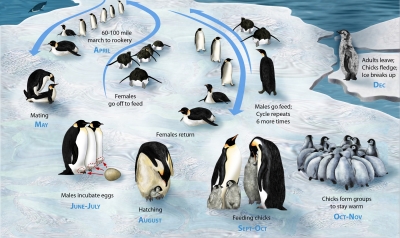
The Emperor penguin is the largest species of penguin, reaching heights of around four feet (1.2 meters) tall, and weighing between 49 pounds (22 kilograms) and 99 pounds (44 kilograms).
They are recognizable due to their distinctive black back and head, white breast and yellow patches on their necks.
Emperor penguins breed and raise their young almost exclusively on sea ice, with the females laying eggs before heading off to hunt for food, leaving the males to incubate the egg.
After the chick is born, parents take turns foraging at sea and caring for the newborn within the colony.
The birds’ diet consists primarily of fish, but they will also eat crustaceans, such as krill, and cephalopods, such as squid. To facilitate hunting the penguins can remain underwater for up to 18 minutes, diving to a depth of 1,755 ft.
The relationship between Emperor penguins and sea ice is fragile.
If there’s too little sea ice, it reduces the availability of breeding sites and prey, but too much ice means longer hunting trips for adults, which means they can’t feed their chicks as frequently.
Picture Credit : Google

